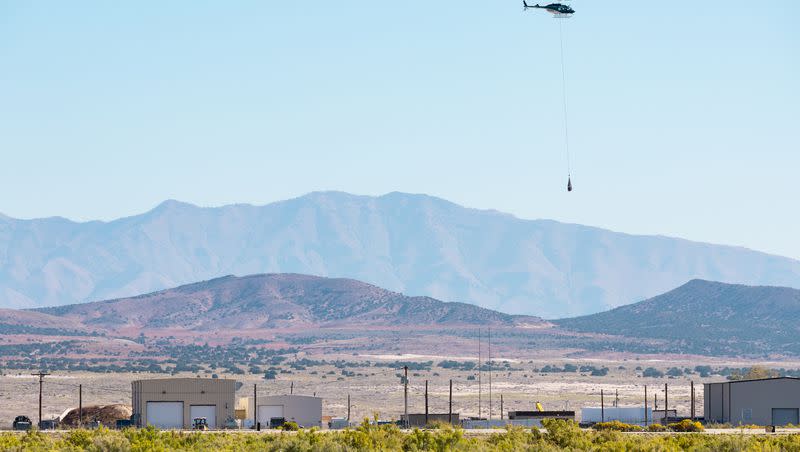Year in space: Moon-to-Mars mission, asteroid sample retrieval and ‘rapid unscheduled disassemblies’ make 2023 one to remember

Earthlings expanded their collective reach into, and knowledge of, the cosmos in 2023, launching mega rockets, traveling billions of miles to bring asteroid samples back to Terra Prime and doing remarkable things like growing the ultra-exclusive moon landing club and peeking into the deepest reaches of the known universe.
Along the way were plenty of reminders of the grand expense, risks and frustrations that accompany humankind’s journeys to new discoveries.
Last month, SpaceX’s second attempt to put its massive Starship vehicle into orbit ended much like the first try in April, in a fiery explosion triggered by flight termination safety equipment. SpaceX social media managers kept things light and positive amid the fire and fury, tweeting after the April failure that the Starship had “experienced a rapid unscheduled disassembly.” But the Nov. 17 launch made it a bit further into the mission than the first attempt, and SpaceX is already readying a third try from its purpose-built launch facility in Boca Chica, Texas. The Elon Musk-owned private space company has found plenty of success with its workhorse Falcon 9 rocket system, including the ability to return and reuse critical and pricey components like first stage rocket boosters. Musk and his team of engineers see the pair of Starship explosions as necessary iterations on the way to perfecting a package powered the world’s most powerful rocket, the SpaceX Super Heavy.
NASA, however, has some worries about how the Starship program is progressing and particularly so as a multibillion-dollar contract is in play as part of the multiphase Artemis program that’s aiming to put humans back on the moon for the first time in over 50 years.
At dawn from the gateway to Mars, the launch of Starship’s second flight test pic.twitter.com/ffKnsVKwG4
— SpaceX (@SpaceX) December 7, 2023
Utah played a starring role in a global space exploration saga in late September when NASA’s Osiris-Rex asteroid sample return mission concluded with the successful landing of a small capsule in the state’s west desert.
The Osiris-Rex mission launched from Earth in 2016 on a journey that brought it to an orbit around Bennu in 2018. In October 2020, the craft touched down briefly on the asteroid, extending a robotic arm to capture a sample from the body’s surface. Bennu is a near-Earth asteroid, meaning it is on a path that orbits the sun. Bennu’s trek around the sun takes 435 days but every six years the asteroid passes relatively close — within about 186,000 miles — to Earth. For reference, that’s closer to Earth than the moon. Ahead of the opportunity to evaluate material from Bennu in person, scientists had a wealth of information gathered by Osiris-Rex over the two years it circled and observed the asteroid.

Shortly after confirmation of the capsule’s soft landing on the morning of Sept. 24 inside the boundaries of the Defense Department’s Utah Test and Training Range, about 80 miles southeast of Salt Lake City, NASA Administrator Bill Nelson celebrated the success and congratulated all of those involved in the $1 billion project that saw the Osiris-Rex spacecraft blast off from Kennedy Space Center over seven years ago.
“Congratulations to the Osiris-Rex team,” Nelson said via a NASA livestream the morning of the landing. “You did it. You designed it. You built it. And you carried out the first (U.S.) mission to collect a sample from an asteroid. And after a two-year journey it has touched down at the Utah desert.
“It brought something extraordinary, the largest asteroid sample ever received on Earth. It’s going to help scientists investigate planet formation, it’s going to improve our understanding of asteroids that could possibly impact the Earth and it’ll deepen our understanding of the origin of our solar system and its formation.”
It's a story 4.5-billion years in the making. See what's next for the asteroid samples returned today by #OSIRISREx.
Post-landing news briefing: https://t.co/Tik2R4kU8t
Mission blog: https://t.co/Kb5TMjeMQ9 pic.twitter.com/Xq2uRLyl9e— NASA (@NASA) September 24, 2023
In August, India became the first nation to land a spacecraft near the moon’s south pole, winning a multinational race to reach the area and joining an elite group of countries that have successfully landed on the Earth’s sole satellite.
The landing made India the fourth country, in addition to the U.S., Russia and China, to have landed spacecraft on the moon.
Indian Prime Minister Narendra Modi watched the Aug. 23 landing of the Chandrayaan-3 spacecraft from South Africa, where he was participating in the BRICS nations summit.
“India is now on the moon. India has reached the south pole of the moon — no other country has achieved that. We are witnessing history,” Modi said as he waved the Indian tricolored flag, per The Associated Press.
In a surge of activity that echoes the multinational race to plant the first flag at the Earth’s south pole around the turn of the 20th century, the world’s leaders in extraterrestrial exploration have been vying to be the first to do the same at the lunar south pole. And all are keenly interested in finding out more about a single, precious commodity on the moon.
Water.
Russia was poised to be the first nation to land a spacecraft near the moon’s south pole on just days before India’s landing, but the state-run space corporation Roscosmos reported its Luna-25 lander ran into trouble and crash-landed on the surface of the moon.
In April, a mission to put a lander near the moon’s south pole overseen by a private Japanese space company also ended in a crash.
Scientists are accumulating mounting evidence that water ice could exist on or near the moon’s surface and believe one of the most likely areas to find it could be in permanently shaded locations near the satellite’s south pole. Water access will be a necessary component in any plans for a long-term human presence on the moon as a life necessity, source of oxygen production, a potential material for shielding against constant radiation bombardment, and is a material that can be refined into its base components of oxygen and hydrogen to fuel potential rocket launches from the lunar surface.
🚨 WE HAVE TOUCHDOWN!!! 🏁
40 days, 3 hrs & 29 mins after launch, CHANDRAYAAN-3 has successfully touched down on the Lunar surface!! 🌖
MASSIVE congrats to @isro & the global spaceflight community!
The south polar region of the Moon is no longer empty! 🛰️#Chandrayaan3 #ISRO pic.twitter.com/hHL58zJHhB— ISRO Spaceflight (@ISROSpaceflight) August 23, 2023
Following its successful launch of the unmanned Artemis I mission last year, NASA announced the crew members of the Artemis II mission currently scheduled to take astronauts on a journey that will included orbits around the moon in late 2024. This spring, NASA announced the four crew members, comprised of American and Canadian astronauts, who will participate in the 10-day Artemis II flight test, powered by NASA’s giant Space Launch System rocket, aiming to test the Orion spacecraft’s life-support systems and further validate the capabilities and techniques needed for humans to live and work in deep space.
“The Artemis II crew represents thousands of people working tirelessly to bring us to the stars. This is their crew, this is our crew, this is humanity’s crew,” NASA Administrator Bill Nelson said in an April press release. “NASA astronauts Reid Wiseman, Victor Glover, and Christina Hammock Koch, and CSA astronaut Jeremy Hansen, each has their own story, but, together, they represent our creed: E pluribus unum — out of many, one. Together, we are ushering in a new era of exploration for a new generation of star sailors and dreamers — the Artemis Generation.”
The as-yet unscheduled Artemis III mission will attempt to put astronauts back on the surface of the moon for the first time since the Apollo 17 crew visited Earth’s sole satellite in 1972.
Wiseman. Glover. Koch. Hansen.
The next four Moon explorers have been chosen. The Artemis II mission now has a crew.
Congratulations to our fellow astronauts! Godspeed and ad astra as your journey begins. Go #Artemis!
More: https://t.co/6tMHM26iY5 pic.twitter.com/0nF4XOpFvT— NASA Astronauts (@NASA_Astronauts) April 3, 2023
In its first year of operations, NASA’s James Webb Space Telescope “pulled back the curtain on some of the farthest galaxies, stars and black holes ever observed; solved a longstanding mystery about the early universe; found methane and carbon dioxide in the atmosphere of a planet outside our solar system; and offered new views and insights into our own cosmic backyard,” according to the agency.
Featured in the first-ever White House Advent Calendar for the 2023 holidays, a new image captured by the Webb telescope reveals never-before-seen details in the remnants of a massive exploded star that is the youngest known supernova in the Milky Way Galaxy.
“Like a shiny, round ornament ready to be placed in the perfect spot on a holiday tree,” NASA said the images of Cassiopeia A captured by Webb’s near-infrared cameras reveal intricate details of the expanding shell of material slamming into the gas shed by the star before it exploded.
Cassiopeia A is located in the Cassiopeia constellation some 11,000 light-years from Earth. Light from the supernova event, the youngest known remnants in our galaxy, first reached Earth 340 years ago and is one of the most-studied space phenomena.
“With NIRCam’s resolution, we can now see how the dying star absolutely shattered when it exploded, leaving filaments akin to tiny shards of glass behind,” Danny Milisavljevic of Purdue University, who leads the research team, said in a NASA blog post. “It’s really unbelievable after all these years studying Cas A to now resolve those details, which are providing us with transformational insight into how this star exploded.”
To: You, From: The Universe 🎁
This stunning new Webb image is a gift from a past star. In near-infrared light, supernova remnant Cassiopeia A (Cas A) resembles a shiny ornament. Embedded within gas from the star are the materials for new stars & planets: https://t.co/9kIvQtEnpb pic.twitter.com/vzzaWrzPBA— NASA Webb Telescope (@NASAWebb) December 11, 2023

